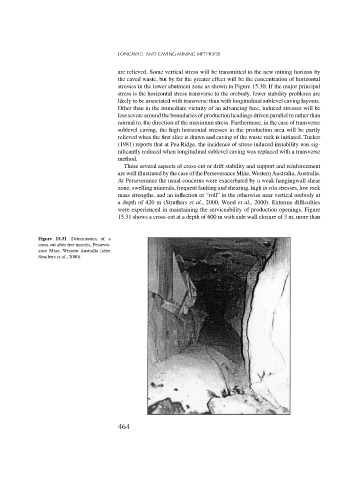Page 482 - Rock Mechanics For Underground Mining
P. 482
LONGWALL AND CAVING MINING METHODS
are relieved. Some vertical stress will be transmitted to the new mining horizon by
the caved waste, but by far the greater effect will be the concentration of horizontal
stresses in the lower abutment zone as shown in Figure 15.30. If the major principal
stress is the horizontal stress transverse to the orebody, fewer stability problems are
likely to be associated with transverse than with longitudinal sublevel caving layouts.
Other than in the immediate vicinity of an advancing face, induced stresses will be
less severe around the boundaries of production headings driven parallel to rather than
normal to, the direction of the maximum stress. Furthermore, in the case of transverse
sublevel caving, the high horizontal stresses in the production area will be partly
relieved when the first slice is drawn and caving of the waste rock is initiated. Tucker
(1981) reports that at Pea Ridge, the incidence of stress-induced instability was sig-
nificantly reduced when longitudinal sublevel caving was replaced with a transverse
method.
These several aspects of cross-cut or drift stability and support and reinforcement
are well illustrated by the case of the Perseverance Mine, Western Australia, Australia.
At Perseverance the usual concerns were exacerbated by a weak hangingwall shear
zone, swelling minerals, frequent faulting and shearing, high in situ stresses, low rock
mass strengths, and an inflection or “roll” in the otherwise near vertical orebody at
a depth of 420 m (Struthers et al., 2000, Wood et al., 2000). Extreme difficulties
were experienced in maintaining the serviceability of production openings. Figure
15.31 shows a cross-cut at a depth of 600 m with side wall closure of 3 m, more than
Figure 15.31 Deterioration of a
cross-cut after five months, Persever-
ance Mine, Western Australia (after
Struthers et al., 2000).
464

